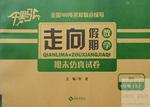题目内容
10.What does the woman advise the man to do?A.Turn down the music. B.Go to bed early. C.Set an alarm.
分析 略
解答 4.C
点评 略

练习册系列答案
 千里马走向假期期末仿真试卷寒假系列答案
千里马走向假期期末仿真试卷寒假系列答案
相关题目
9.We can find we need at the Suguo Supermarket,which saves us a lot of time.( )
| A. | whichever | B. | whatever | C. | wherever | D. | whomever |